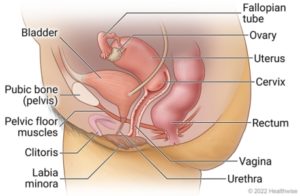Pain. It’s such a simple word and universal experience, yet it is incredibly complex. If you’ve ever had pain “down there” and have talked with a health professional, you’ve likely heard about all of the things that can cause pelvic pain. For the purposes of this blog, pelvic pain is considered any pain that occurs from your belly button and below, or the lower abdomen and below.

We know how scary it can be to have pain, especially when you don’t know what is causing it. Our Care Team is here to help you explore what is causing your pain, educate you about the condition, and support you as the pain is treated. We will be by your side for every step of the journey.
A Few Causes of Pelvic Pain
Periods
The uterus (womb) is a muscle that contracts during the menstrual period to expel blood. Some women don’t even notice the uterine contractions while other women can experience significant discomfort prior to and during their periods, along with other PMS symptoms. Although menstrual cramping is uncomfortable for many women and can be a normal part of the menstrual cycle, women with conditions such as uterine fibroids (non-cancerous growths of uterine tissue), endometriosis (lining of the uterus tissue is outside of the uterus), or adenomyosis (lining of the uterus tissue grows inside the muscle of the uterus) are all associated with more pain during menstruation.
Ovaries and Fallopian Tubes
The ovaries that release eggs during reproductive years, are regularly creating cysts that sometimes release an egg. Some women will have minimal discomfort during the middle of their menstrual cycle which is called mittelschmerz and accompanies the release of an egg from an ovarian cyst. Sometimes ovarian cysts do not get the correct signal to release an egg and continue to grow, or are a non-egg releasing cyst. Your Diana Health team has expertise in diagnosing and treating ovarian cysts, so if you believe your are experiencing this, please reach out and book a visit!
Urinary
The bladder lies just in front of and is connected to the uterus, making it hard to sometimes distinguish uterine pain from bladder pain. Bladder pain can be caused by common urinary tract infections, as well as less common conditions such as interstitial cystitis (painful bladder syndrome due to inflammation or irritation of the bladder). Clues that pain may be caused by a urinary tract infection include pain while urinating, feeling a strong and/or prolonged urge to urinate, or urinating more frequently. Kidney stones, especially when moving down through the tubes going to your bladder, can cause severe pain. In addition, the urethra that carries urine from the bladder to outside, can also become inflamed leading to pain “down there”.
Gastrointestinal
Your small and large intestines fill a large part of your abdomen and pelvis. That means everything from common gastrointestinal issues such as gas pain and irritable bowel syndrome to more rare issues such as Crohn’s disease, can cause pain down there. Change in bowel movements, constipation, diarrhea, or bloody stools increase the likelihood that pain may be coming from an intestinal issue or even the rectum where stool exits. Although many chronic gastrointestinal issues are not emergent, there are some such as an acute appendicitis that require emergency attention.
Musculoskeletal
Muscles, ligaments, tendons, and bones are located in the abdomen and pelvis and can be a source of pain, too. From low back pain to a pulled groin muscle, a muscle spasm or even round ligament pain that is common during pregnancy, pain originating from a muscle or supporting structure is common. Sometimes musculoskeletal pain may be diagnosed when the pain occurs only with a specific movement or if there is tenderness when a particular muscle or region is touched. Pelvic organ prolapse can also be associated with discomfort when the bladder, uterus, and sometimes even the rectum can descend lower than they were originally located.
Neuropathic
Throughout your entire body, a network of nerves connects your brain and spinal cord to your abdomen and pelvis. The nervous system and how your brain “interprets” sensations are related to pain. Some people have neuropathic pain which is (GET DEFINITION) when nerves become extra sensitive or irritated, even when there is not a stimulus. Sometimes we don’t even know the underlying cause of neuropathic pain. This makes it challenging to ___.
Vulva and vagina
The skin of the vulva and vagina is extra sensitive. If this skin is exposed to something that it is allergic to, irritation and pain can occur. There are also some skin conditions that happen to this tissue that can lead to pain. Yeast infections, bacterial vaginosis, or sexually transmitted infections can cause uncomfortable irritation. This may be accompanied by abnormal vaginal discharge, itching, or possibly an odor and should be evaluated by a medical professional. Irritation of the vulva and vagina may be caused due to genitourinary syndrome of menopause, as estrogen levels decrease and irritation occurs.
Precautions
If your pain is severe, sharp, or comes on suddenly, seek immediate medical attention as it could be a sign of a medical emergency. Pain that is accompanied by a fever, vomiting, blood in urine or stool, excessive vaginal bleeding, or loss of consciousness/fainting is especially worrisome and requires immediate medical evaluation.
At-Home Treatments for Chronic Pain
If your pain is not severe, it did not come on suddenly, and is not accompanied by the worrisome signs above, you may want to try at-home treatments while waiting to connect with your healthcare professional. First, reach out and schedule an appointment with Diana Health or other healthcare provider. When you schedule, let them know about your pain so that you can get a treatment time that is appropriate for your pain. If the pain worsens prior to your appointment, reach out to your healthcare provider or if it becomes severe or accompanied by worrisome symptoms, seek emergency attention immediately.
Home treatments may include:
- Changing positions to find what is most comfortable
- Taking over-the-counter pain relievers such as ibuprofen
- Using warmth on the lower abdomen and pelvis from a heating pad or warm water bottle. Do not apply this directly to the skin.
- Try to relax through mindful breathing, meditation, or other methods that help you manage your stress
- Try to distract yourself by engaging in other activities that take your attention away from the pain
- Engage in physical activity if that makes your pain feel better
- Enjoy an herbal tea such as peppermint or chamomile
Pain journal
It’s important to connect with your primary care provider and work as a team to explore potential underlying causes as well as how to treat the pain. You are a team. In order to help the exploration process, consider keeping a pain journal that you share with your healthcare team.
- Time: Notice when your pain occurs. Does it start soon after eating or just when you urinate?
- Consistency: Notice if the pain comes and goes in waves or if it is constant.
- Better or worse: Notice what makes the pain better or worse. Does laying down make it better? Does twisting your back or vaginal intercourse make it worse?
- Type: Notice what the pain “feels” like. Is it sharp and stabbing or dull and aching?
- Location: Notice where the pain is located. Does it stay in one place and if so where is that location? Does it tend to move around?
- Severity: Notice how severe the pain is at any given time. You can note, on a scale of 0-10 with 0 being no pain to 10 being the most severe pain you can imagine, how bad the pain is at the current moment.
At Diana Health, we care about you and are here to listen to you and understand your experience. Your pain is as unique as you are, and we know that experiencing pain can be scary and frustrating, especially if it takes time to uncover the cause and how to decrease or eliminate the pain. Stay connected with your Diana Health care team and let us know how you are doing. We are here to help you every step of the way. Whether it’s medication, physical therapy, surgery, watchful waiting, or another treatment, know that we are here for you and we care about you. You can book a visit with us online, or find the location nearest to you and give us a call.



